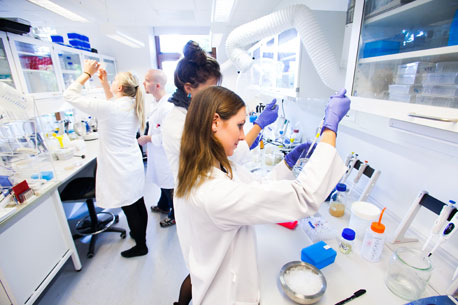Students Behind Novel SynBio-Lightsource

Today, Friday 5th of October, seven SCIENCE students are traveling to Amsterdam to participate in the innovative bio-design world championship for students: The highly distinguished iGEM competition. They are bringing two valuable things with them to Amsterdam: Fluid bio-neon, the result of their own invention – and real life experiences gained from being researchers all through the summer.
When the European round of the iGEM competition (international Genetically Engineered Machine) is happening tomorrow October 6th in Amsterdam, a group of SCIENCE students will take the floor with their pockets full of big dreams and a single groundbreaking idea. The highly esteemed competition gathers thousands of students every year from all over the world. They all spend their summers doing synthetic biology and bio-designing living cells so they can perform specific, useful functions.
University of Copenhagen is participating for the second time – and this year’s group is entering the competition with with its own design: bio-neon, based on cyanobacteria. These bacteria are designed to emit light during the night, and thereby work as a sustainable light source in the dark.
Crossdisciplinary training
UNICPH’s iGEM ’12 team does not only include SCIENCE students. Philosophy student Lea Gregersen from the University’s humanities faculty, Charlotte Krag studying design and innovation at Technical University of Denmark, and Caroline Have, student at Creative Communication at the Danish School of Media and Journalism are also involved with the the team.
”While we worked on making the bacteria glow in the dark, these guys have been responsible for developing concepts for applications, such as ’neon’-signs. They have also been important sparring partners on ethical aspects, which should always be considered when working with living biology interacting with society” says molecular biomedicine student Charlotte Navntoft, to whom iGEM has been an opportunity to early on gaining experience with the potential of the interdisciplinary collaborations that form the basis of synthetic biology and in society-oriented research generally.
Skip the Summer Break – Get Invaluable Experience as Researcher
Over the summer, she has spent many hours in the laboratory at Department of Plant and Environmental Sciences to develop the glowing bacteria together with the rest of the iGEM team.
”Instead of hanging out on the beach, we have worked as ’real scientists’. We designed and planned our own experiments, which has given us a lot of experience with techniques, which the lab courses only has introduced to us in passing” says Charlotte Navntoft when commenting on the work of the team, which has been supervised by Peter Naur and Johan Andersen-Ranberg, postdoc and PhD-student respectively, both at the same department.
”We have not succeeded in everything, but to learn from your mistakes, to re-adjust and to retry are key parts of the life of a researcher. In this way, we have attained attractive compentences that will add value to our future studies” she says continues with a smile: ”We have for example become world champions in performing PCRs, which is fundamental for DNA-work”.
The Big Day
On Saturday 6th in the afternoon, the show starts in Amsterdam, where the project is be presented for an audience of more than 200 people. The iGEM students are excited but also nervous of course:
”The many other talented teams pose a formidable competition. But we keep our fingers crossed – and no matter what, it will be a huge experience. We are going to have damn good time!” says Charlotte Navntoft.
Facts:
CyanoDelux – perhaps the Bio-Neon of the future
The project of the iGEM team is focused on producing a genetical construct, which causes the cyanobacteria to emit light when they are exposed to darkness for a longer period of time. To this end, the team has used a set of promoters to genes that are involved in the circadian rhythm of bacteria in nature. These promoters are attached to a set of genes that encode the enzymes, which are necessary for the emission of biologically generated light. In this way, the bacteria can fixate carbondioxide from the atmosphere during the day and utilise the produced compentents to emit light at night.
The students have not finalised the project completely, as they have met quite a few challenges on their way. They have, however shedded new light on how one clones large and small DNA-pieces together. Together with the innovative original idea, this also counts in the competition.
The iGEM team is comprised of: Line Alsøe Barrington, Naja Emborg Vinding, Camilla Schwarz, Malte Thodberg, Michel Saremi, Chris Ramming and Charlotte A.E. Navntoft.
Much more information available on the team’s website: https://2012.igem.org/Team:Copenhagen
iGEM – build with biology and share your knowledge
iGEM, which stands for ’international Genetically Engineered Machines’, is organised by the well-reputed university Massachusetts Institute of Technology (MIT) since 2004. This year, more than 2500 students from universities worldwide are participating.
The students participating in the competition build their constructs based on standard components, which they can download through iGEM’s open source DNA-library. Often the iGEM-projects results in the students characterizing new standard components themselves, which are then given back to the library. In this way the open access library, called the ‘biobricks parts registry’, keeps growing and opens up to new possibilities.
Drew Endy, a groundbreaking synthetic biology researcher, came up with the original idea and the development of the competition. He has also founded the organization BioBricks Foundation, who is behind the competition.
Read on here: http://2012.igem.org
